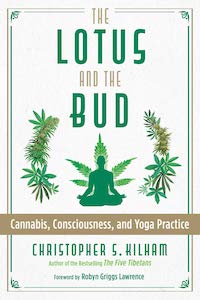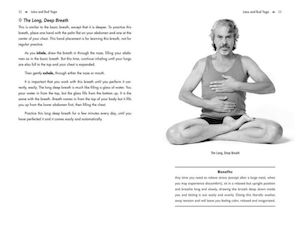
The Lotus and the Bud: Cannabis, Consciousness, and Yoga Practice, by Christopher S. Kilham
Park Street Press, 192 pages, 1620559404, January 2021
The Lotus and the Bud: Cannabis, Consciousness, and Yoga Practice by Christopher S. Kilham is a wonderful guide to deepening one’s explorations into the expanded states of consciousness offered through yoga practice. Unlike most texts on the practice of yoga, however, this one provides knowledge, methods, and advice about how to awaken one’s kundalini energy by combining yogic discipline with the mindful use of cannabis.
Kilham draws upon his decades of yoga practice and the accumulated experiences of his travels around the world to present a comprehensive look at how ganja – his preferred term for this plant medicine – is a perfect companion for fostering growth in the connection between mind, body, and spirit.
I heartily recommend this book for anyone seeking to cultivate an intimate, free-flowing connection with the Universe: to experience the unity of all that is. Yet, while The Lotus and the Bud is incredibly digestible and easy to read, its content is not intended for someone simply looking to spice up their yoga practice. The techniques and wisdom that Kilham offers are geared toward a holistic shift in one’s life.
“In my fifty years of daily practice, I have come to regard yoga as a cosmic current of pure wisdom consciousness that runs through human history. . . Yoga does not choose us because we are special in any manner, but simply suitable for the task of carrying illumination forward.”1

What Kilham presents in The Lotus and the Bud is not merely for the sake of relieving pain, strengthening the body, or calming the mind. Although the practices found in the book can accomplish these ends to a superb degree, the true power of the techniques lies in realizing ultimate oneness with the Universe, and revealing that truth through our daily lives.
He emphatically urges the reader that stepping onto the yoga mat means bringing your whole self to the party: coming to your practice with sincerity, respect, and determination. This naturally entails that you should never infuse with ganja to the extent that you lose the focus and intent of your practice. Being thoroughly baked is good for a cake, not so much for a yogi.
In the first section of the book, and scattered throughout the rest of the text, is an account of Kilham’s own yogic journey, including the insights he learned along the way from teachers, gurus, and his experiences with psychoactive substances and plant medicines. One of the most interesting aspects of this introduction to Kilham’s story is how he navigated the (sometimes treacherous) waters of gurus when he was a young man, learning to discern true teachers from self-serving frauds.
Here, and throughout The Lotus and the Bud, the reader will find many amusing and intriguing quotes about cannabis and its use. These quotes come from people spanning all of history, as well as the present day: from music icons, to U. S. presidents, to Middle Eastern folklore and mythology. My favorite is from Stephen Gray:

“When someone first smokes cannabis, and the conditions are right, something remarkable and concerning happens. . . The user is suddenly thrust upon a world of wonder, relaxation, humor, passion, creativity, and perhaps even gnosis.”2
The book winds its way through the history, cultural milieu, and spiritual significance of yoga and cannabis, each with its own dedicated section. Kilham provides a succinct overview of the chakras and the general essence of yogic practice. His purpose is not to provide a full treatise on yoga and its practice, but he does well in establishing the groundwork so that even a yoga novitiate can understand the guiding principles. In a similar vein, Kilham presents a brief, multicultural account of cannabis, its use throughout history, and defends its validity as a medicinal herb.
What I enjoyed most about these informative sections is the frequent inclusion of mythology. In fact, the reader will learn that, in Hindu culture, yoga and cannabis have one and the same origin – the god Siva. Even in ancient times, these people recognized that yoga and ganja were a match made in heaven, both presented as gifts to humanity so that we might experience “absorption into limitless and unfathomable spirit.”3
As with any mythological viewpoint, one doesn’t need to share a literal belief about the origin of these gifts, but I think it creates a beautiful link between past and present, especially after cannabis was so fiercely attacked and regulated in more recent eras. Our recent (re)discovery of the beneficial nature of ganja, in particular, and its potent combination with yoga is rightly seen as a continuation of physical, mental, and spiritual explorations that have gone on throughout human history.
Kilham also is also very good at weaving in the current scientific investigations and discoveries with the historical narrative of ganja. The recent findings about the body’s endocannabinoid system reveal that it has the ability to affect almost every other system and organ. Kilham observes that infusing ganja into yoga practice allows one to better tune in to the flow of energy within the body. Since the endocannabinoid system assists in holistic regulation of the body, Kilham thinks its functions correspond to the activity of the energetic body: notably, the chakra energy centers.

The second half of the book contains more direct guidance from Kilham about the proper attitudes and helpful techniques that will make the most of your ganja-yoga experience. One piece of advice that I’d never heard before was to focus on feeling rather than visualizing during yoga. Although visualization can be helpful in expanding your awareness of the body’s energetic flow, Kilham’s experience suggests that feeling into what’s taking place in your corporeal form is a path of direct access to your energetic state. He also covers the gamut of methods for infusing with cannabis, and presents good reasons why some are better for this practice than others.
Finally, Kilham goes through a fair number of yoga asanas, meditation, and relaxation techniques that he recommends specifically for expanding your kundalini energy. For each of these, he provides clear and simple instructions as well as a list of mental and physical benefits.
In all, I found The Lotus and the Bud as a surprisingly comprehensive dive into the beautiful and beneficial relationship between ganja and yoga. Kilham brings a bounty of learning to the table, using both academic research and life experience to convey the wisdom found in the marriage between the lotus and the bud. Although it will take time and dedication to unlock the full splendor of Siva’s gifts, the journey sounds well-worth the effort.

Zak has two master’s degrees in philosophy, from Brandeis University and University of California Santa Barbara. He is currently the lead editor for Dungeons in a Box, and he spends much of his time in the realm of fantasy crafting new plots and ensuring the adventure is in mechanical balance. When he’s not DMing, he also enjoys hiking, studying eastern philosophy, and playing board games.

Thanks so much for the thoughtful and insightful review. I greatly appreciate to. Best to you. happy trails- Chris